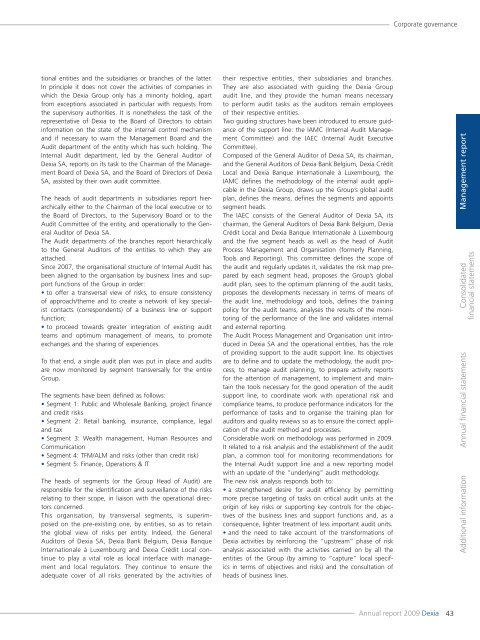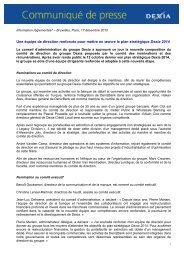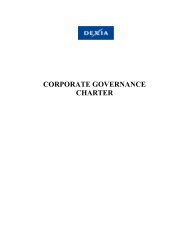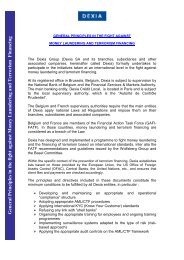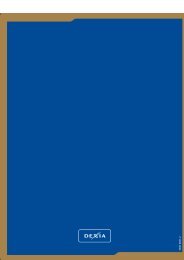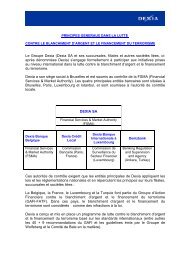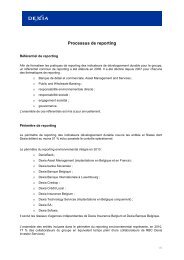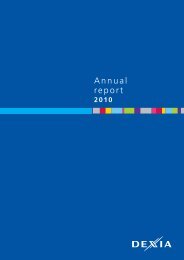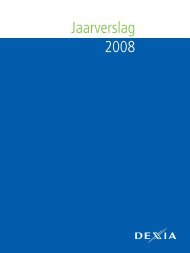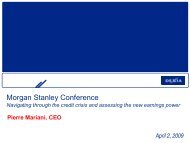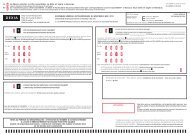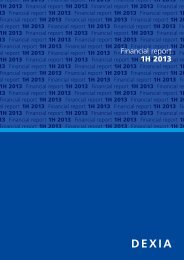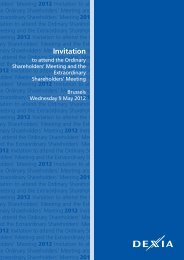Annual report 2009 - Dexia.com
Annual report 2009 - Dexia.com
Annual report 2009 - Dexia.com
- No tags were found...
Create successful ePaper yourself
Turn your PDF publications into a flip-book with our unique Google optimized e-Paper software.
Corporate governancetional entities and the subsidiaries or branches of the latter.In principle it does not cover the activities of <strong>com</strong>panies inwhich the <strong>Dexia</strong> Group only has a minority holding, apartfrom exceptions associated in particular with requests fromthe supervisory authorities. It is nonetheless the task of therepresentative of <strong>Dexia</strong> to the Board of Directors to obtaininformation on the state of the internal control mechanismand if necessary to warn the Management Board and theAudit department of the entity which has such holding. TheInternal Audit department, led by the General Auditor of<strong>Dexia</strong> SA, <strong>report</strong>s on its task to the Chairman of the ManagementBoard of <strong>Dexia</strong> SA, and the Board of Directors of <strong>Dexia</strong>SA, assisted by their own audit <strong>com</strong>mittee.The heads of audit departments in subsidiaries <strong>report</strong> hierarchicallyeither to the Chairman of the local executive or tothe Board of Directors, to the Supervisory Board or to theAudit Committee of the entity, and operationally to the GeneralAuditor of <strong>Dexia</strong> SA.The Audit departments of the branches <strong>report</strong> hierarchicallyto the General Auditors of the entities to which they areattached.Since 2007, the organisational structure of Internal Audit hasbeen aligned to the organisation by business lines and supportfunctions of the Group in order:• to offer a transversal view of risks, to ensure consistencyof approach/theme and to create a network of key specialistcontacts (correspondents) of a business line or supportfunction;• to proceed towards greater integration of existing auditteams and optimum management of means, to promoteexchanges and the sharing of experiences.To that end, a single audit plan was put in place and auditsare now monitored by segment transversally for the entireGroup.The segments have been defined as follows:• Segment 1: Public and Wholesale Banking, project financeand credit risks• Segment 2: Retail banking, insurance, <strong>com</strong>pliance, legaland tax• Segment 3: Wealth management, Human Resources andCommunication• Segment 4: TFM/ALM and risks (other than credit risk)• Segment 5: Finance, Operations & ITThe heads of segments (or the Group Head of Audit) areresponsible for the identification and surveillance of the risksrelating to their scope, in liaison with the operational directorsconcerned.This organisation, by transversal segments, is superimposedon the pre-existing one, by entities, so as to retainthe global view of risks per entity. Indeed, the GeneralAuditors of <strong>Dexia</strong> SA, <strong>Dexia</strong> Bank Belgium, <strong>Dexia</strong> BanqueInternationale à Luxembourg and <strong>Dexia</strong> Crédit Local continueto play a vital role as local interface with managementand local regulators. They continue to ensure theadequate cover of all risks generated by the activities oftheir respective entities, their subsidiaries and branches.They are also associated with guiding the <strong>Dexia</strong> Groupaudit line, and they provide the human means necessaryto perform audit tasks as the auditors remain employeesof their respective entities.Two guiding structures have been introduced to ensure guidanceof the support line: the IAMC (Internal Audit ManagementCommittee) and the IAEC (Internal Audit ExecutiveCommittee).Composed of the General Auditor of <strong>Dexia</strong> SA, its chairman,and the General Auditors of <strong>Dexia</strong> Bank Belgium, <strong>Dexia</strong> CréditLocal and <strong>Dexia</strong> Banque Internationale à Luxembourg, theIAMC defines the methodology of the internal audit applicablein the <strong>Dexia</strong> Group, draws up the Group’s global auditplan, defines the means, defines the segments and appointssegment heads.The IAEC consists of the General Auditor of <strong>Dexia</strong> SA, itschairman, the General Auditors of <strong>Dexia</strong> Bank Belgium, <strong>Dexia</strong>Crédit Local and <strong>Dexia</strong> Banque Internationale à Luxembourgand the five segment heads as well as the head of AuditProcess Management and Organisation (formerly Planning,Tools and Reporting). This <strong>com</strong>mittee defines the scope ofthe audit and regularly updates it, validates the risk map preparedby each segment head, proposes the Group’s globalaudit plan, sees to the optimum planning of the audit tasks,proposes the developments necessary in terms of means ofthe audit line, methodology and tools, defines the trainingpolicy for the audit teams, analyses the results of the monitoringof the performance of the line and validates internaland external <strong>report</strong>ing.The Audit Process Management and Organisation unit introducedin <strong>Dexia</strong> SA and the operational entities, has the roleof providing support to the audit support line. Its objectivesare to define and to update the methodology, the audit process,to manage audit planning, to prepare activity <strong>report</strong>sfor the attention of management, to implement and maintainthe tools necessary for the good operation of the auditsupport line, to coordinate work with operational risk and<strong>com</strong>pliance teams, to produce performance indicators for theperformance of tasks and to organise the training plan forauditors and quality reviews so as to ensure the correct applicationof the audit method and processes.Considerable work on methodology was performed in <strong>2009</strong>.It related to a risk analysis and the establishment of the auditplan, a <strong>com</strong>mon tool for monitoring re<strong>com</strong>mendations forthe Internal Audit support line and a new <strong>report</strong>ing modelwith an update of the “underlying” audit methodology.The new risk analysis responds both to:• a strengthened desire for audit efficiency by permittingmore precise targeting of tasks on critical audit units at theorigin of key risks or supporting key controls for the objectivesof the business lines and support functions and, as aconsequence, lighter treatment of less important audit units.• and the need to take account of the transformations of<strong>Dexia</strong> activities by reinforcing the “upstream” phase of riskanalysis associated with the activities carried on by all theentities of the Group (by aiming to “capture” local specificsin terms of objectives and risks) and the consultation ofheads of business lines.Management <strong>report</strong>Consolidatedfinancial statements<strong>Annual</strong> financial statementsAdditional information<strong>Annual</strong> <strong>report</strong> <strong>2009</strong> <strong>Dexia</strong> 43


